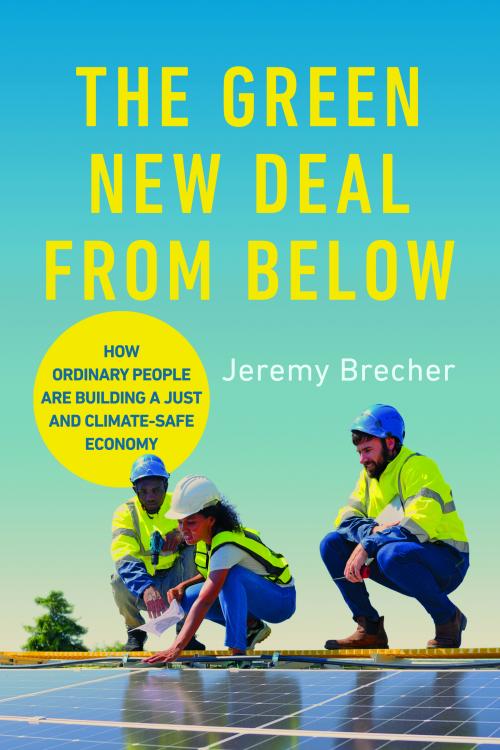A sample of local activities include:
Boston City Council Member Michelle Wu lead the city’s decades long efforts to address climate and justice issues, resulting in cost effective public transportation using electric vehicles, community-based EV car share and school bus services, a Heat Plan and Climate Ready program for low income neighbourhoods Temperature Response Task Force, Urban Forest Plan and Solarization Plan; all of which include re skilling workers for good jobs, many of them within unions.
Unions
Los Angeles’ Green New Deal also has addressed both immediate goals and long term security goals in its “five zeroes” plan: Zero Carbon Grid, Zero Carbon Buildings, Zero Carbon Transportation, Zero Waste and Zero Wasted Water.
The Seattle New Green Deal mobilized 10,000 citizens and 200 organizations to demand “a people-powered movement demanding that the City of Seattle create its own plan to eliminate climate pollution by 2030.”
Brecher concludes the chapter with brief case studies on greening and social justice city initiatives with a scorecard of actions on community-wide, buildings, transportation, energy and water, and local operations initiatives in Orlando; Portland; Denver; Washington, DC; San Jose; New York City and San Francisco.
Each initiative incorporates justice-oriented policies and budgets with performance standards. These examples, Brecher underscores, “show what is needed and what is possible.” The keys to success are alliances and coalitions: with unions, community organisations, churches and businesses.
Next The Green New Deal from Below describes state level actions, which further the drive the economy to a better future.
Hopelessness
Hawaii sends “A Postcard from the Future” as the first state to require that all electricity come from renewable sources and banned coal-fired power plants; all schools must have net-zero energy by 2025; a doubling of locally produced food for schools cafeterias.
Illinois’ Future Energy Jobs Act, supported by the Illinois Clean Jobs Coalition offers $5 billion for energy efficiency, job training and rooftop solar energy for low-income home owners and renters.
California, Maine, Massachusetts, Oregon, Rhode Island and Washington are members of the global Under 2 Coalition, which convenes over 270 sub national governments representing 1.75 billion people.
Justice Louis Brandeis famously called the states as laboratories within the federal structure. “Today,” Brecher writes, the states are “serving as laboratories of the Green New Deal.”
The Green New Deal from Below is a priority read for those who have fallen into despair and hopelessness about the state of our country and prospects for world peace. Copious notes and index allow the reader to follow up for further information and research.

Solving
Yet as thorough as Brecher’s accounts of activity at the state and local level, there is more good news. Organisations and coalitions are active throughout the country fighting monopoly control over energy, broadband and media, healthcare and food production and distribution.
Citizens and activists can follow the local actions to subdue monopolies through the newsletters of such organizations as the Institute for Local Self-Reliance, Center for Ecological Technology, Fight Corporate Monopolies, Zero Waste International Alliance; as well as join and support local Zero Waste organizations and local chapters of the Sierra Club, Clean Water Action and Beyond Plastics.
Zero Waste is scarcely mentioned in The Green New Deal from Below.
Yet this movement, started in the mid-1990s, subsumed the combined recycling movement of the1970s which brought the country to 35 per cent recycling level (before stagnation in 2000 caused by concentrated waste industry monopolies); and the anti-garbage incineration movement of the 1980s, which stopped over 400 garbage incinerators from being built and is now focused on shutting down the remaining 55 facilities.
The movement has shown its ability to wage decades-long battles and has shown competence in solving problems.
Waste
This was demonstrated in the work building reuse companies that train and employ low skilled workers for jobs with family wage – simultaneously reducing recidivism of former offenders – and benefit levels in the building deconstruction, appliance, electronic products repair and resale.
Grass roots leaders have proven their competence in sighting new landfills, reducing the flow of waste to public landfills by 50 per cent in three years, built Resource Recovery Industrial Parks for recycling, composting and reuse companies in California, Texas and Florida.
The Zero Waste sector of the US economy has an estimated 1.5 million direct jobs and is larger than the automobile industry.
The history for this momentous effort by organised citizens is a worthy subject for historians such as Brecher. To date the political economy of waste in the US has been only partially documented.
Devolve
See “Recycling”, Wiley Brothers Encyclopedia, 1995: Wasting 2000, Grass Roots Recycling Network, 2000; Stop Wasting the Climate, ILSR, 2008; and, “Zero Waste Takes Off” and “The Long Road to Zero Waste”, Resource Recovery Magazine, April and June, 2024.
Happily, an account of the citizen leaders who orchestrated the recycling, anti incineration and Zero Waste movements has been carefully edited by the US Recycling Archives Project, started by the Waste to Wealth Initiative of ILSR and Urban Ore, Inc. is now available.
The stories of the diverse array of ordinary citizens – teachers, students, air line pilots and stewardesses, stand up comics, doctors, World War II veterans – who started and lead this movement are now available as The Founders’ Heart.
George Orwell wrote in the 1930s that the only way to prevent war is to devolve decision-making to the local level. The US is alive with citizen-based organisations and national coalitions who are working toward this worthy goal.
This Author
Neil Seldman, PhD, directs the Recycling Cornucopia Program at Zero Waste USA.


